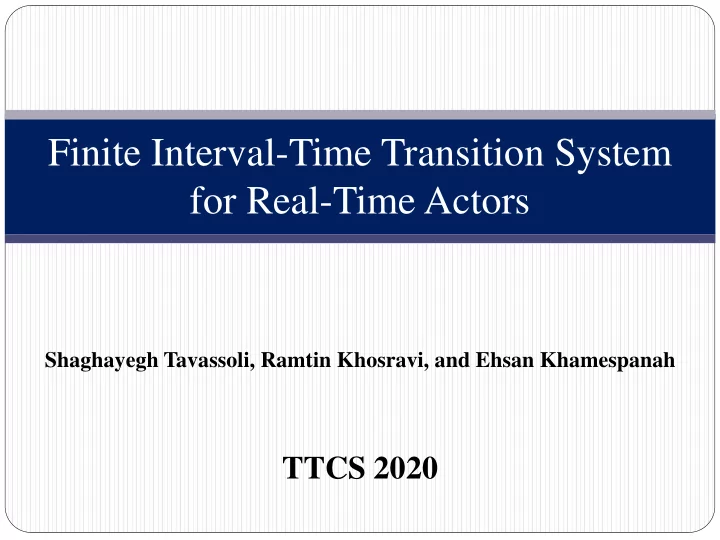

Finite Interval-Time Transition System for Real-Time Actors Shaghayegh Tavassoli, Ramtin Khosravi, and Ehsan Khamespanah TTCS 2020
Introduction 1/23
Introduction Real-time systems 1/23
Introduction Real-time systems Non-deterministic time behavior 1/23
Introduction Real-time systems Non-deterministic time behavior Distributed real-time systems 1/23
Introduction Real-time systems Non-deterministic time behavior Distributed real-time systems Timed-Rebeca 1/23
Purpose of this paper 2/23
Purpose of this paper Presenting a time-interval extension to Timed-Rebeca 2/23
Purpose of this paper Presenting a time-interval extension to Timed-Rebeca Introducing Interval-Time Transition System (ITTS) 2/23
Timed-Rebeca reactiveclass PingClass(3) { reactiveclass PongClass(3) { knownrebecs { knownrebecs { PongClass pong1; PingClass ping1; } } Statevars { msgsrv pong() { //e.g. int v1, v2; ping1.ping() after(1); } delay(i); PingClass() { } self.ping() } } main { msgsrv ping() { pong1.pong() after(1); PingClass pi(po) : (); delay(2); PongClass po(pi) : (); } } } Timed-Rebeca model of ping-pong example (from [1] with slight modifications) 3/23
Timed-Rebeca with intervals reactiveclass PongClass(3) { reactiveclass PingClass(3) { knownrebecs { knownrebecs { PingClass pi; PongClass po; } } PongClass() { PingClass() { self.pong(); self.ping() } } msgsrv pong() { pi.ping() after([8,16)); msgsrv ping() { } po.pong() after([8,16)); } } main { } PingClass pi(po) : (); PongClass po(pi) : (); } 4/23
Interval Time Transition System (ITTS) Notation and basic definitions States in ITTS Order of events in ITTS Transitions definition 5/23
Notation and basic definition 6/23
Notation and basic definition Time intervals: 6/23
Notation and basic definition Time intervals: Updating an interval: 6/23
Notation and basic definition Time intervals: Updating an interval: Message definition: 6/23
States in ITTS Local state of an actor with ID x : 7/23
States in ITTS Local state of an actor with ID x : Global system state: 7/23
Global system state example 8/23
Order of events in ITTS gs 1 : msg1 msg2 msg3 Time EE 1 (gs 1 ) EE 2 (gs 1 ) EE 3 (gs 1 ) 9/23
Transitions Message processing Taking a message from the message bag Internal transition Time progress (TP) Type 1 Type 2 10/23
Message processing gs 1 : msg1 msg2 msg3 Time Time interval of gs 1 11/23
Message processing Taking a message from the message bag 12/23
Message processing Taking a message from the message bag Internal transition Assignment statement Send statement 12/23
Message Processing 13/23
Type 1 time progress s: gs 1 : msg1 msg2 Time Time interval of gs 1 14/23
Type 1 time progress s: gs 2 : msg1 msg2 Time Time interval of gs 2 14/23
Type 1 time progress 15/23
Type 2 time progress s: gs 1 : msg1 msg2 Time Time interval of gs 1 16/23
Type 2 time progress s: gs 2 : msg1 msg2 Time Time interval of gs 2 16/23
Type 2 time progress ds(mb,t) changes the lower bound of messages in mb which start earlier than t , to t . 17/23
Type 2 time progress ds(mb,t) changes the lower bound of messages in mb which start earlier than t , to t . 17/23
Making state space finite No explicit time reset operator 18/23
Making state space finite No explicit time reset operator Modeling recurrent behavior 18/23
Making state space finite No explicit time reset operator Modeling recurrent behavior Equivalence between two states in ITTS 18/23
Shift equivalence relation in ITTS Equivalence of two time intervals: 18/23
Shift equivalence relation in ITTS Equivalence of two time intervals: Equivalence of two messages: 18/23
Shift equivalence relation in ITTS Equivalence of two local states of an actor with ID x : 19/23
Shift equivalence relation in ITTS Equivalence of two local states of an actor with ID x : Equivalence of two global system states: 19/23
Two equivalent states 20/23
Shift equivalence relation in ITTS Shift equivalence relation in ITTS is a bisimulation relation: 21/23
Conclusion 22/23
Conclusion Presenting an extension to Timed-Rebeca 22/23
Conclusion Presenting an extension to Timed-Rebeca Using Timed-Rebeca with intervals for modeling nondeterministic time behavior 22/23
Conclusion Presenting an extension to Timed-Rebeca Using Timed-Rebeca with intervals for modeling nondeterministic time behavior Defining the semantics of Timed-Rebeca with intervals as ITTS 22/23
Conclusion Presenting an extension to Timed-Rebeca Using Timed-Rebeca with intervals for modeling nondeterministic time behavior Defining the semantics of Timed-Rebeca with intervals as ITTS Preventing state space explosion using shift equivalence relation in ITTS 22/23
References M. Sirjani and E. Khamespanah , “On time actors,” in Theory 1. and Practice of Formal Methods, vol. 9660 of Lecture Notes in Computer Science , 2016, pp. 373 – 392. 23/23
Thank you
Recommend
More recommend